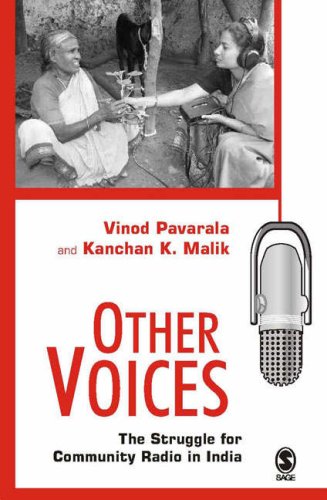For more than fifteen years, India has been experiencing a turbulent period of transformations in the broadcasting system. The launch of STAR TV in 1991, followed by a proliferation of domestic and international channels, opened up the formerly state-run broadcasting system to commercial competition. While the impact of this change on audiences has been thoroughly studied, much of this work has focused on affluent, well-educated, urban audiences.
Other Voices convincingly directs our attention to the rural poor, those people in India who are still in the majority, but are very much left out of the new media sphere. The main goal of Other Voices is to advocate for community radio as an important means for empowering marginalized groups in society. Vinod Pavarala, dean, and Kanchan K. Malik, lecturer, at the Sarojini Naidu School of Performing Arts, Fine Arts and Communication at the University of Hyderabad, are long-term activists in the Indian movement to establish community radio. They bring to this project the perspectives of empirical researchers but also of passionate media advocates. The main part of the book analyzes four non-governmental community radio projects in Jharkhand, Gujarat, Karnataka, and Andhra Pradesh. The evaluation of these projects is contextualized in a wider global media policy framework. 
The book's strength is the well-documented argument the authors advance. Pavarala and Malik support a "three-tier system" of participatory community media beside state-run/public and commercial broadcasters. In this Internet era, many communication scholars tend to forget that radio as a low-tech medium has tremendous advantages. It is fairly inexpensive to produce and receive, overcomes the hurdles of illiteracy, and does not even require steady electric power. While the particular circumstances vary, all of the cases studies are projects launched during the last decade amongst some of the poorest and most disadvantaged people in remote parts of India. The authors led a team of field researchers who conducted focus groups of listeners and participants as well as interviews with producers and reporters who were often recruited as volunteers from local communities. Of note is how the authors connect the specifics of their cases to more general concerns such as their potential for creating effective counterpublics, participatory communication, and gender equality. Another strength of this book lies in the thick description of the case studies. Empowering moments are in abundance, such as the villagers in Karnataka who listened to a program they produced as "tears rolled down their cheeks." Or the illiterate women who, after hearing their issues addressed in their local languages, gained the confidence to participate in village councils. There are even successful instances of political change, such as the village chief who finally initiated a much-needed repair to water pipes only after he was worried the radio station would broadcast the villagers' concerns. The radio programs ranged from women's concerns (such as dowry abuse or girls' right to education) and to general issues affecting the villages, such as corruption, alcohol abuse, or lack of electricity or water. Beyond developmental programs these stations also served as archives and protectors of local languages, music, and stories. The authors carefully evaluate the limitations of radio as an agent of change. Just as a young man in impoverished Jharkhand heatedly asked the researchers "Can we eat radio?", Pavarala and Malik don't see radio as a "quick fix" for social problems. They also report that despite best intentions the most disenfranchised people (illiterate and very poor, especially women) tended to participate the least. A less convincing part of the book is the second chapter in which the authors present a comparison of community radio frameworks in several countries (Australia, Ireland, South Africa, Canada, United States). While it makes sense to understand the media development in India in a more global context, the choice of these countries is not clear. Also, the underlying assumption that many other countries already have well-established community radio systems is too optimistic. In the United States, for example, community radio's counterpublic potential is often drowned out by an overwhelming commercial media output. While the authors hope that India can learn from examples abroad, media activists anywhere can learn from the Indian example how to orchestrate a concerted grass-root effort to change media policy. Now that the Indian parliament finally ratified guidelines for launching community radio (in late 2006), it will be crucial to translate these impressive first projects into sustained endeavors. At worst, the country ends up with a system of local but disconnected stations with small groups of villagers talking to themselves. At best, independent but well-funded efforts can enable marginalized people to establish broader political will. Even for people less optimistic about community radio than the authors, this book presents a thought-provoking case for anyone interested in the potential of mass media to create more informed and engaged citizens.
|